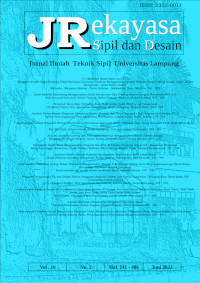The Effect of U-Turn on Travel Delay Based on Shockwave Review
DOI:
https://doi.org/10.23960/jrsdd.v9i1.1643Abstract Views: 219 File Views: 111 File Views: 0
Abstract
Pangeran Antasari St. is a road with a high level of congestion, especially during peak hours. This of course causes cumulation of vehicles which will making queues of vehicles. The congestion and density have caused a lot of shockwaves phenomena in the traffic around Pangeran Antasari St. This study examines the shockwaves in the trip delay which are influenced by the U-turn. The data was collected at Pangeran Antasari St. on October 5, 2020 during 06.00-09.00 am and 15.00-18.00 pm. The types of vehicles observed were Motorcycle (MC), Light Vehicle (LV), and Heavy Vehicle (HV).
The shockwaves value obtained using the Greenshield Method of Pangeran Antasari St. at the morning section obtained the shockwaves value with the value of the reverse shockwaves (ωab) = -2284.98 km/h, the reverse shockwaves recovery (ωcb) = -16.2602 km/h, shockwaves forward recovery (ωac) = 55.707 km/h. At the afternoon, the shockwaves value is obtained with the value (ωab) = 3,3706 km/h; reverse shock wave recovery (ωcb) = -10.0224 km/h; forward shock wave recovery (ωac) 5.6654 km/h. The queue length (Qm) that occurs is 0.05 km or 53 m with a normalizing time (T) of 20.4279 seconds.
Downloads
References
Salter R.J., 1976. Highway Traffic Analysis and Design, The Macmillan Press Ltd. Melbourne.
Tamin, Ofyar Z., 2003. Perencanaan dan Pemodelan Transportasi, Penerbit ITB, Bandung.
Tamin, Ofyar Z., 2008. Perencanaan dan Pemodelan Transportasi, Penerbit ITB, Bandung.
Downloads
Additional Files
Published
How to Cite
Issue
Section
License

JRSDD is licensed under a Creative Commons Attribution-NonCommercial 4.0 International License.

